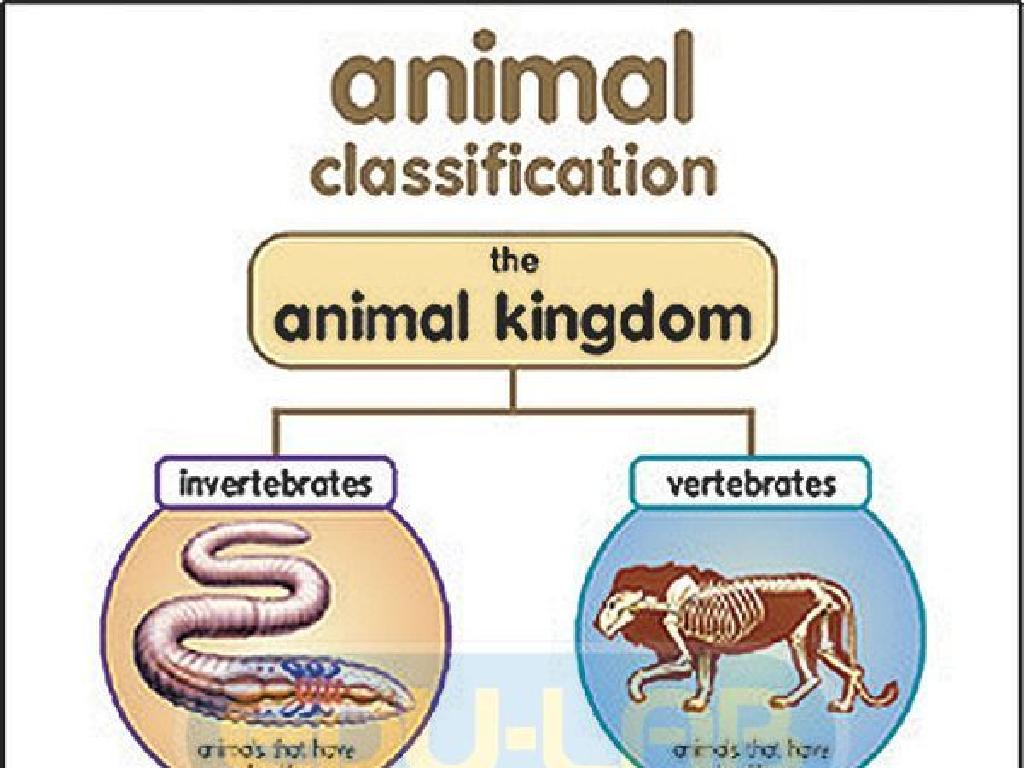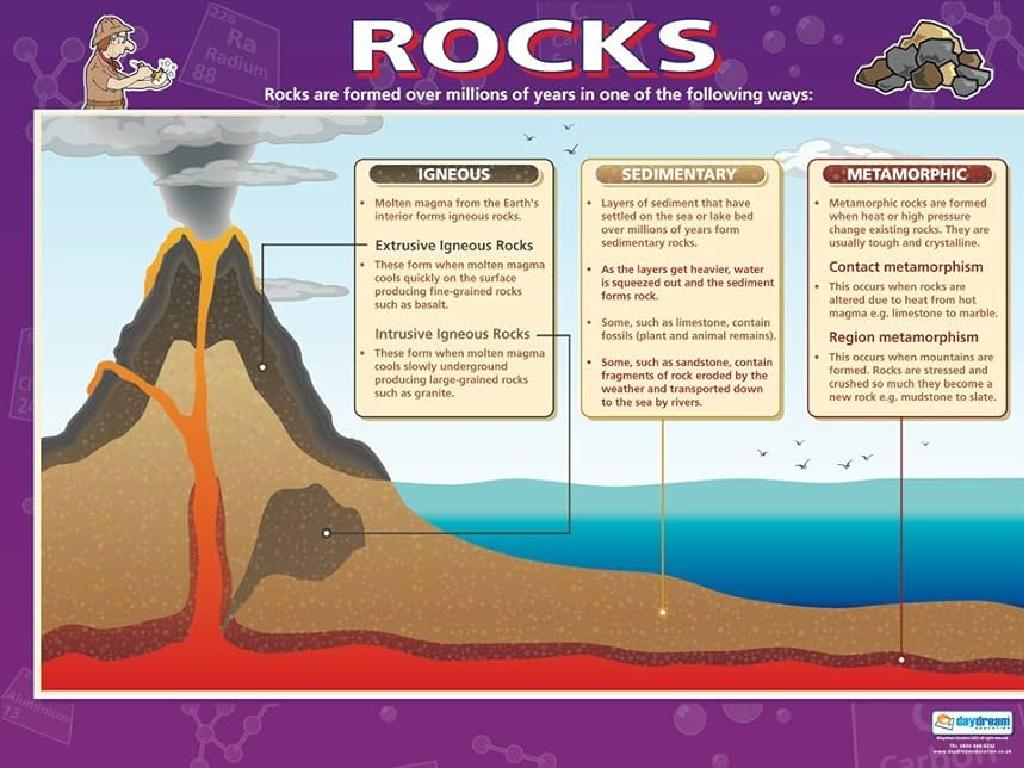Match Problems With Their Solutions
Subject: Language arts
Grade: Eighth grade
Topic: Text Structure
Please LOG IN to download the presentation. Access is available to registered users only.
View More Content
Text Structure: Problems & Solutions
– Explore text building blocks
– Match problems with solutions
– Identify a problem, then find the text’s response or resolution
– Significance in literacy skills
– Understanding this structure improves comprehension and analytical writing
– Engage with examples
– Use sample paragraphs to practice finding problems and their solutions
|
This slide introduces the concept of text structure, focusing on the ‘problem and solution’ approach, which is a common pattern in reading and writing. Emphasize the importance of recognizing this structure to enhance reading comprehension and to improve the ability to write coherent and structured responses. Encourage students to actively engage with texts by identifying the problem presented and the solution provided. This skill is crucial for critical thinking and for understanding more complex literary and informational texts. Provide examples from familiar stories or articles and guide students through the process of matching problems with their solutions. This will prepare them for class activities where they will apply this concept to new texts.
Understanding Text Structure: Problem & Solution
– Define text structure
– How information is organized in writing
– Purpose of different structures
– Each structure has a specific use in writing
– Common text structures
– Includes types like Compare & Contrast, Cause & Effect, etc.
– Focus on Problem & Solution
– Analyze how problems are presented and solved in text
|
This slide introduces the concept of text structure, an essential element in reading comprehension and writing. Text structure refers to the way information is organized within a written passage, and understanding it helps students to analyze and create texts effectively. Highlight the different purposes served by various text structures, such as comparing and contrasting ideas, showing cause and effect relationships, or outlining a sequence of events. Emphasize the problem and solution structure, where students learn to identify issues presented in a text and understand how the author proposes solutions. Provide examples from familiar texts and encourage students to think of real-life scenarios where this structure is applicable.
Understanding Problem & Solution Structure
– Recognize ‘problem & solution’ structure
– A text layout where a challenge is outlined followed by a fix
– Key words: problem, solution, resolve
– Words like ‘issue’, ‘consequently’, ‘therefore’ signal this structure
– Applicable to various texts
– Found in both stories and informational texts
– Practice identifying in reading
– Find examples in homework or class readings
|
This slide introduces students to the problem and solution text structure, which is a common format in both fiction and non-fiction. It’s important to highlight that this structure helps readers to understand and analyze the text by looking for specific keywords that signal the presence of a problem followed by its resolution. Encourage students to look for these clues in their reading assignments and to practice identifying this structure by finding real examples. This will not only enhance their comprehension skills but also their ability to critically engage with the text. Provide a variety of reading materials for students to apply this concept.
Identifying Problems in Text
– Spotting problems in texts
– Clues: challenge, dilemma, obstacle, issue
– Example: City’s water shortage
– A severe water shortage is a significant problem that a city might encounter.
– Analyzing the impact of the problem
– Consider how the problem affects characters or situations.
|
This slide aims to teach students how to identify problems within a text, which is a key component of understanding text structure. Start by explaining that problems are often presented as challenges or obstacles that characters must overcome. Highlight keywords such as ‘challenge,’ ‘dilemma,’ ‘obstacle,’ and ‘issue’ that often signal a problem. Use the example of a city facing a severe water shortage to illustrate a clear problem. Encourage students to think about why recognizing problems is important for comprehension and analysis of the text. Discuss how identifying the problem can lead to exploring its effects and looking for solutions presented by the author. Have students practice by finding problems in texts they are currently reading.
Finding Solutions in Text
– Solutions follow problems
In narratives, solutions typically come after problems are introduced.
– Search for solution clues
Words like ‘solved’, ‘addressed’, ‘improved’ hint at solutions.
– Example: City water conservation
The city faced a drought and responded with water-saving measures.
– Analyze the effectiveness
Discuss how the solution impacted the problem.
|
This slide aims to teach students how to identify solutions in a text, which is a key component of understanding text structure. Emphasize that solutions are usually presented after the problem has been described. Teach students to look for specific clues or keywords that indicate a solution is being proposed or implemented. Use the example of a city implementing water conservation programs to illustrate a real-world solution to a problem. Encourage students to think critically about how effective the solutions are and to consider the outcome or results of the solution. This will help them not only to identify solutions but also to evaluate the text more deeply.
Matching Problems with Solutions in Texts
– Importance of matching in comprehension
– Understanding the relationship improves grasp of the text’s message.
– Techniques to link problems & solutions
– Look for keywords, cause-effect signals, and solution indicators.
– Practice with an example paragraph
– Identify the issue and how it is resolved in the provided text.
– Enhancing reading skills
|
This slide aims to highlight the significance of matching problems with their solutions as a critical reading comprehension skill. Students should understand that recognizing this relationship can greatly enhance their grasp of the material. Teach them to look for specific keywords or phrases that signal a problem or solution, such as ‘challenge’, ‘issue’, ‘resolve’, or ‘consequently’. During practice, provide a paragraph and guide students to pinpoint the problem presented and the solution offered. This exercise will not only improve their analytical skills but also their ability to understand and interpret various text structures. Encourage students to apply these techniques to their own reading assignments.
Let’s Practice: Problem & Solution
– Read a passage as a class
– Pinpoint the problem stated
– What is the main issue or conflict?
– Brainstorm potential solutions
– Think of different ways to solve the problem
– Locate the text’s solution
– How does the passage resolve the issue?
|
This slide is for a class activity focused on understanding the problem and solution text structure. Start by reading a passage together, ensuring that students are following along and comprehending the content. After reading, engage the class in identifying the central problem presented in the text. Open a discussion for students to suggest possible solutions, fostering critical thinking and creativity. Finally, guide them to find and understand the solution that the text provides. For the teacher: Prepare a passage with a clear problem and solution, facilitate the discussion to keep it on track, and be ready with prompts in case students need help. Possible activities include group discussions, individual reflection, or creating a graphic organizer to map out the problem and solution identified in the passage.
Group Activity: Problem-Solution Match
– Match problem with solution cards
– Discuss the reasoning behind matches
– Why does this solution work for this problem?
– Present your matches to the class
– Reflect on the activity
– Think about what you learned from this exercise
|
This group activity is designed to enhance students’ understanding of the problem-solution text structure. Divide the class into small groups and provide each with a set of problem cards and solution cards. Students will work together to match each problem with the correct solution. After matching, they should discuss as a group why they believe the solution fits the problem, encouraging critical thinking and justification of their reasoning. Each group will then present their matches to the class, explaining their thought process. This activity not only reinforces the concept of problem-solution but also fosters teamwork and public speaking skills. As a teacher, facilitate the activity by guiding discussions and ensuring each group understands the objective. After presentations, lead a reflection session where students can discuss what they learned and how this structure is applicable in various texts.
Class Activity: Crafting Problem & Solution Paragraphs
– Write a problem-solution paragraph
– Pair and discuss your paragraph
Exchange paragraphs, provide feedback on clarity of problem and solution
– Volunteer to present to the class
Sharing helps with public speaking & critical thinking skills
– Reflect on the exercise
Think about how identifying problems and solutions helps in understanding text structure
|
This activity is designed to enhance students’ understanding of the problem and solution text structure. Each student will write a paragraph that outlines a problem and then proposes a solution. After writing, students will pair up to discuss their paragraphs, providing an opportunity for peer feedback. Encourage students to focus on clarity and detail in both the problem and the solution. Volunteers can then share their work with the class, which will help in developing public speaking and critical thinking skills. Conclude the activity with a reflection on how identifying problems and solutions can aid in comprehending various texts. Provide guidance on how to structure a paragraph effectively and offer examples of problem-solution scenarios.
Wrapping Up: Problem & Solution
– Recap problem-solution structure
– Why it’s key in texts
– Homework: Analyze an article
– Find a current article, pinpoint a problem and the proposed solution.
– Explain why solutions work
– Justify the effectiveness of the solution based on the context.
|
As we conclude, reiterate the problem and solution text structure, emphasizing its importance in comprehending and analyzing texts. For homework, students should find a recent article, identify a problem presented, and the solution provided. They must then write a brief explanation of why the solution works, encouraging them to think critically about the text. This exercise will help solidify their understanding of the text structure and its application in real-world scenarios. In the next class, be prepared to discuss different articles and solutions identified by students, fostering a collaborative learning environment.






